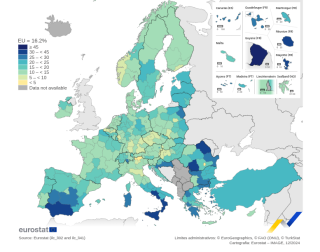Poverty across the EU

Eurostat recently published figures on poverty rates across the EU. In 2023, 71.7 million people across the EU (16.2 per cent) of the population were found to be at risk of poverty. [1] This rate is calculated using national poverty thresholds. Figure 1 presents the at risk of poverty at regional level.
Figure 1: People at risk of poverty by NUTS, 2023 (%)

Ten regions in the EU had a share of people at risk of poverty at above 30 per cent. These were in the outmost region of France, Guyane, where more than half (53.0 per cent) of the people were at risk of poverty, followed by Calabria (40.6 per cent) and Sicilia (38.0 per cent) in Italy.
In contrast then, 26 regions recorded shares below 10 per cent. The Romanian region of Bucureşti-Ilfov had the lowest rates of people at risk of poverty (2.1 per cent), followed by the Italian region Provincia Autonoma di Bolzano/Bozen (3.1 per cent) and the Belgian region Prov. Oost-Vlaanderen (5.4 per cent).
‘A Europe of Equals?’ - some key findings*
Social Justice Ireland's recent publication, A Europe of Equals, is the sixteenth publication in Social Justice Ireland’s European Research Series. This report noted the trend of increasing poverty rates among older persons in the European Union. This is very concerning with more than 5 million additional older people across the EU experiencing poverty since 2014. Almost 16 million older people (17 per cent) in the EU are at risk of poverty, with almost twice as many older women being affected than older men. This trend of rising poverty among older people is of significant concern, given that populations are ageing at an unprecedented rate.
In addition, the average material and social deprivation rate for older people has increased in the past year, now standing at 5.5 per cent, or 4.9 million older people. These trends must be tracked carefully given that disimprovements are happening at a time of population ageing as well as growth and recovery in Europe.
The pension gap between men and women across the EU remains large and is likely to persist, and people who are in non-standard work or are self-employment often face less favourable conditions for accessing and accruing pension rights. The growth of precarious work situations makes this an issue of increasing concern.
Headline figures:
- In 2022, 16.5 per cent of the population of the European Union was at risk of poverty, almost 73 million people.
- 13.2 million people unemployed.
- 4.5 million people long-term unemployed.
- 2.8 million young people aged under 25 unemployed (highest in Spain, Greece and Italy).
Older people:
- Over 17 per cent of people over 65 were at risk of poverty in the EU in 2022. This amounts to 15.9 million older people.
- There is a significant gender difference at older ages, with far more women (10.3 million) being affected by poverty than men (5.7 million).
- The highest rates occurred in some of the newer accession countries of Estonia (52.3 per cent), Latvia (40.5 per cent), Lithuania and Bulgaria. The lowest rates were seen in Slovakia (9.1 per cent), Luxembourg, and France (each under 13 per cent).
- Ireland ranks as among the top three EU member states with the highest increases in poverty and social exclusion experienced by older people since 2021.
- This trend of increasing poverty rates among older people in the EU since 2014 is of significant concern, given that populations are ageing at an unprecedented rate.
Child poverty:
- Close to one-fifth (19.3 per cent) of children in Europe (15.6 million) are living in poverty.
- Four member states have child poverty rates above 25 per cent; Spain, Romania, Bulgaria and Italy.
- Ongoing high levels of poverty or social exclusion amongst children is one of the most challenging and serious issues faced by Europe, not least because it can affect the rest of one’s life and a tendency to live in poverty can be passed on to future generations.
In-work poverty:
- Close to one-in-ten employed people in the EU live in poverty on an ongoing basis.
- In work poverty affected 8.6 per cent of employed people (aged 18+) in the EU in 2022, an alarming 20.5 million workers. Getting people into work is not always sufficient to lift them out of poverty.
- Some groups are particularly affected (including younger people, people with lower education levels, and non-standard workers, poor households with children including lone parents).
Financial distress:
- Financial distress (defined as the need to draw on savings or to run into debt to cover current expenditures) is greatest among households on the lowest incomes.
- The lowest quartile (or lowest 25 per cent) of households in the EU experienced a rate of financial distress of 28 per cent in 2024.
Recommendations
Research has consistently shown that a more integrated social dimension across the European Union is required to meet the challenges of the present. This report points to the need to develop a social welfare and support system that can adapt to changing realities and withstand future shocks. Minimum income schemes, adequate investment and access to quality services are essential prerequisites to future European prosperity, not barriers to it.
The ageing of Europe’s population, the fact that there are many more women than men in this group, and the very great differentials between countries make poverty amongst older people (especially in some countries) an issue that requires more attention now and in the future. The situation children and of those who work and still live in poverty must be tackled as a matter of urgency. Economic issues are still allowed to dominate social and environmental issues, and this must change. Leadership at EU level in relation to vulnerable groups is critical not just to the future economic and social outlook but also to the democratic future of Europe”.
[1] https://ec.europa.eu/eurostat/statistics-explained/index.php?title=Glos…
* (all figures relate to 2022 for EU-27 comparison purposes).
